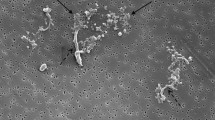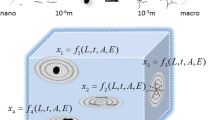Abstract
The importance of the conditions at the stem-cement interface in cemented total joint replacements (THRs) with regard to the in vivo longevity of the implant is well recognized. In the present study, we used a simplified model of one part of a cemented THR (alloy rectangular beam bonded to rectangular cement plate) to study the influence of surface finish of the alloy beam (stem) on two measures of the evolution of random damage at the alloy beam-cement plate interface (stem-cement interface), under quasi-static direct shear load. Three surface finishes of the beams were used: satin-finish, grit-blasted, and plasma-sprayed. The random damage events were monitored from the emitted acoustic signals, with the two measures computed from these signals being the intensity of random damage events (IRDE) and the mean damage event energy (MDEE). Large number of random damage events (higher values of IRDE and low value of MDEE) occurred with grit blasted specimens, suggesting a high probability for the generation of debris particles at the interface. These findings, in conjunction with details on the size and shape of the debris particles, obtained using scanning electron microscopy, lead to the suggestion that satin-finish stems are desirable for use in cemented THRs.






Similar content being viewed by others
References
Wang JS, Taylor M, Flivik G, Lidgren L. Factors affecting the static shear strength of the prosthetic stem–bone cement interface. J Mater Sci: Mater Med. 2003;14:55–61.
Mann KA, Damron LA, Miller MA, Race A, Clarke MT, Cleary RJ. Stem-cement porosity may explain early loosening of cemented femoral hip components: experimental-computational in vitro study. J Orthop Res. 2007;25(3):340–50.
Bishop NE, Ferguson S, Tepic S. Porosity reduction in bone cement at the cement–stem interface. J Bone Joint Surg. 1996;78-B:349–57.
Race A, Miller MA, Ayers DC, Cleary RJ, Mann KA. The influence of surface roughness on stem–cement gaps. J Bone Jnt Surg. 2002;84B:1199–204.
Race A, Miller MA, Clarke MT, Mann KA. Cement-implant interface gaps explain the poor results of CMW3 for femoral stem fixation: a cadaver study of migration, fatigue and mantle morphology. Acta Orthop. 2005;76:679–87.
Wang JS, Franzen H, Lidgren L. Interface gap after implantation of a cemented femoral stem in pigs. Acta Ortho Scand. 1999;70:234–9.
Damron LA, Kim DG, Mann KA. Fatigue debonding of the roughened stem-cement interface: effects of surface roughness and stem heating conditions. J Biomed Mater Res Part B: Appl Biomater. 2006;78B:181–8.
Dall DM, Miles AW, Juby G. Accelerated polymerization of acrylic bone cement using preheated implants. Clin Orthop Relat Res. 1986;211:148–50.
Mann KA, Damron LA, Race A, Ayers DC. Early cementing does not increase debonds energy of grit blasted interfaces. J Orthop Res. 2004;22:822–7.
Crowninshield RD, Jennings JD, Laurent ML, Maloney WJ. Cemented femoral component surface finish mechanics. Clin Orthop Relat Res. 1998;355:90–102.
Barb W, Park JB, Kenner GH, von Recum AF. Intramedullary fixation of artificial hip joints with bone cement-precoated implants. I. Interfacial strengths. J Biomed Mater Res. 1982;16:447–58.
Bundy KJ, Penn RW. The effect of surface preparation on metal/bone cement interfacial strength. J Biomed Mater Res. 1987;21:773–805.
Davies JP, Singer G, Harris WH. The effect of a thin coating of polymethylmethacrylate on the torsional fatigue strength of the cement-metal interface. J Appl Biomater. 1992;3:45–9.
Ahmed AM, Raab S, Miller JE. Metal/cement interface strength in cemented stem fixation. J Orthop Res. 1984;2:105–18.
Raab S, Ahmed AM, Provan JW. The quasistatic and fatigue performance of the implant/bone-cement interface. J Biomed Mater Res. 1981;15:159–82.
Mann KA, Edidin AA, Ordway NR, Manley MT. Fracture toughness of CoCr alloy-PMMA cement interface. J Biomed Mater Res. 1997;38:211–9.
Collis DK, Mohler CG. Loosening rates and bone lysis with rough finished and polished stems. Clin Orthop Rel Res. 1998;355:113–22.
Della Valle AMG, Zoppi A, Peterson MGE, Salvati EA. A rough surface finish affects the clinical and radiographic performance of a modern cemented femoral stem. Clin Orthop Relat Res. 2005;436:158–63.
Ong A, Wong KL, Lai M, Garino JP, Steinberg ME. Early failure of precoated femoral components in primary total hip arthroplasty. J Bone Joint Surg. 2002;84-A:786–92.
Della Valle AG, Rana A, Nestor B, Bostrom M, Westrich G, Salvati EA. Metallic shedding, surface finish changes, and extensive femoral osteolysis in the loose Spectron EF stem. Clin Orthop Relat Res. 2006;442:165–70.
Rasquinha VJ, Ranawat CS, Dua V, Ranawat AS, Rodriguez JA. A prospective, randomized, double-blind study of smooth versus rough stems using cement fixation: minimum 5-year follow-up. J Arthroplasty. 2004;19(Suppl 2):2–9.
Vail TP, Goetz D, Tanzer M, Fisher DA, Mohler CG, Callaghan JJ. A prospective randomized trial of cemented femoral components with polished versus grit-blasted surface finish and identical stem geometry. J Arthroplasty. 2003;18(Suppl 1):95–102.
Verdonschot N, Tanck E, Huiskes R. Effects of prosthesis surface roughness on the failure process of cemented tip implants after stem-cement debonding. J Biomed Mater Res. 1998;42:554–9.
Beksac B, Taveras BS, Gonzales DV, Salvati EA. Surface finish mechanics explain different clinical survivorship of cemented femoral stems for total hip arthroplasty. J Long-Term Eff Med. 2006;16(6):407–22.
Heuer DA, Mann KA. Fatigue fracture of the stem-cement interface with a clamped cantilever beam test. J Biomech Eng. 2000;122:647–51.
Qi G, Li J, Mann KA, Mouchon WP, Hamstad MA, Salehi A, et al. 3D real time methodology monitoring cement failures in THA. J Biomed Mater Res A. 2004;71:391–402.
Qi G. Attenuation of acoustic emission body waves in acrylic bone cement and synthetic bone using wavelet time-scale analysis. J Biomed Mater Res. 2000;521:148–56.
Thota S. Acoustic emission detection of X-force horizontal conveyer bearings and sliding material pairs. MS thesis. The University of Memphis; 2008.
Chang PB, Mann KA, Bartel DL. Cemented femoral stem performance. Effects of proximal bonding, geometry, and neck length. Clin Orthop Relat Res. 1998;355:57–69.
Kimura Y, Sugimura J. Microgeometry of sliding surfaces and wear particles in lubricated contact. Wear. 1984;100:33–45.
Waterhouse RB. Fretting corrosion. NY: Pergamon Press; 1972.
Acknowledgments
The project described was supported by Grant Number AR051119 from NIH/NIAMS. The authors would like to thank Mr. Bin Zhang and Dr. Jihui Li for assisting the experimental work.
Author information
Authors and Affiliations
Corresponding author
Rights and permissions
About this article
Cite this article
Qi, G., Wayne, S.F., Mann, K.A. et al. Random damage and characteristics of debris particles are two important and yet ignored factors in the mechanical integrity of the stem-cement interface of a total hip replacement: influence of the surface finish of the metal stem. J Mater Sci: Mater Med 21, 1385–1392 (2010). https://doi.org/10.1007/s10856-009-3946-3
Received:
Accepted:
Published:
Issue Date:
DOI: https://doi.org/10.1007/s10856-009-3946-3




